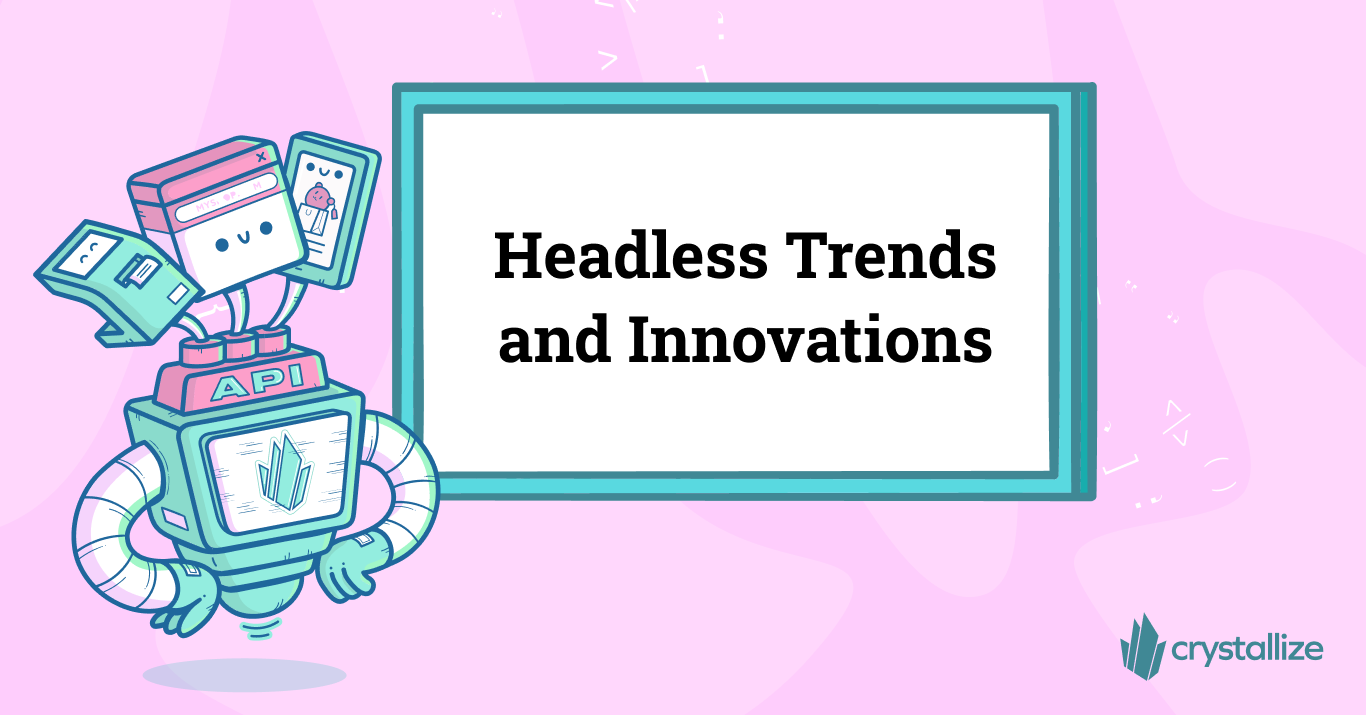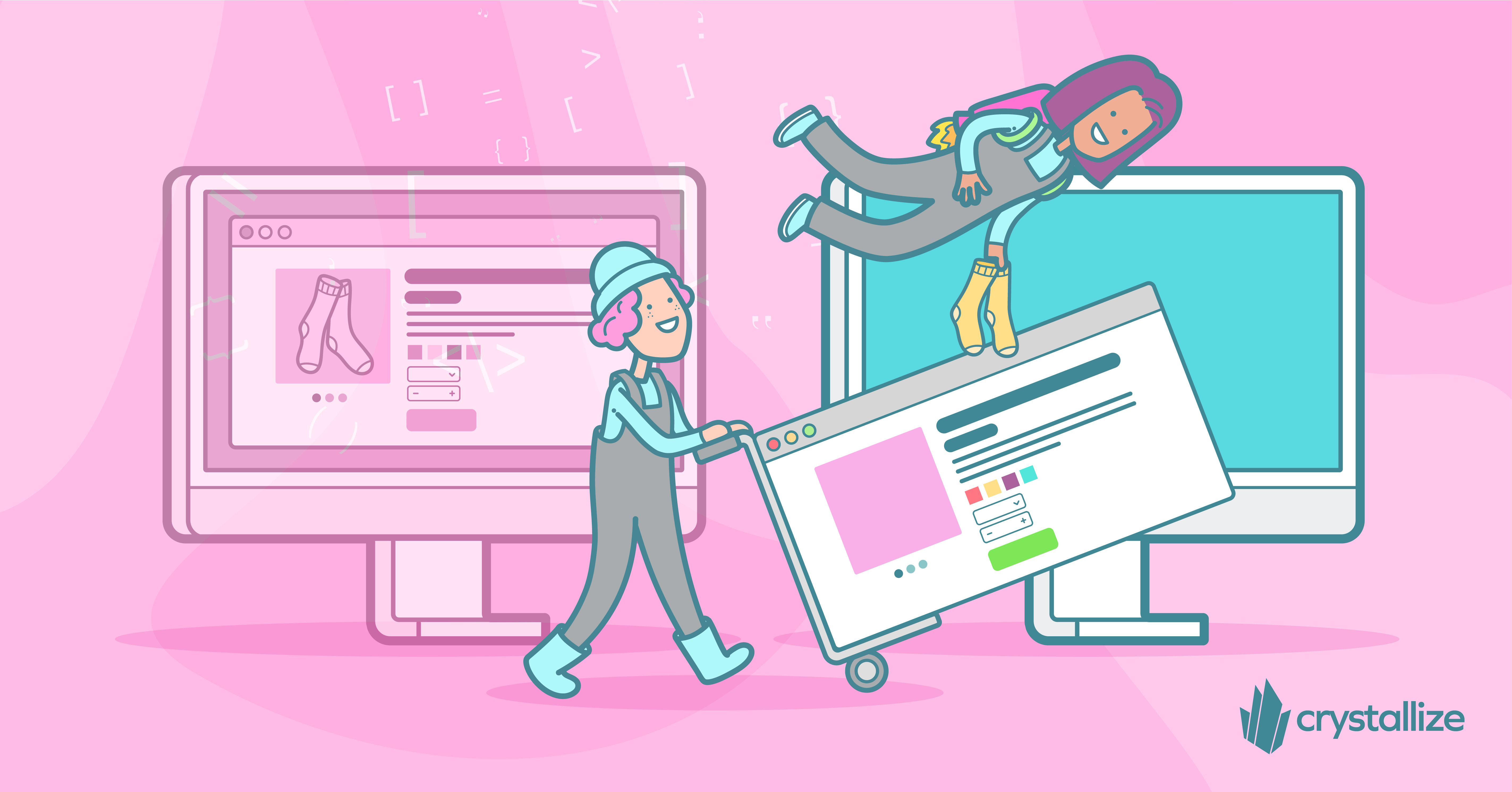The Future of Headless Commerce: Trends and Innovations
A short overview of what is (probably) coming in the world of headless commerce.

It’s smart to know where eCommerce is now. It’s even smarter to know where eCommerce is headed in the future. If you invest time and effort in the right things, such moves may pay off later through higher profits and a large, loyal customer base.
With Crystallize as your backend, it’ll be easy–and fun–to keep up with the latest trends.
Trend 0: Adoption
Let’s start by acknowledging that the adoption of headless eCommerce is a massive trend in and of itself. Over six in ten retail companies surveyed plan to migrate to headless commerce platforms by 2024, while over 20 percent already use them (source).
Why?
Long story short, headless architecture offers many advantages over traditional monolith systems: flexibility, improved performance and time to market, cost savings, and boosted sales from happier customers. What’s not to love?
More eCommerce Trends
For the foreseeable future, headless is here to stay. Crystallize is headless and tech-agnostic, so it’s well-positioned to communicate with any kind of service you might want to work with. That’s good because the future of eCommerce will be full of innovation!
Let’s look at what’s coming and see how Crystallize can help you keep up with the dizzying pace of change.
API-First
API first is an approach to building an online store focusing on the application programming interface (API). Different services can be handled by dedicated APIs or microservices, which the developers and customers input fine-tune. This approach allows for flexibility and quick response to customer feedback, with a better user experience (UX) for developers.
Lower development costs and better performance lead to cost savings for businesses. Business leaders like Amazon, Netflix, and Stripe have already adopted API-first eCommerce. Microservices eCommerce is projected to reach $7.5 trillion in revenues by 2025.
Artificial Intelligence (AI)
AI is huge everywhere these days, and, of course, businesses are seeking ways to enhance their sales with it. Since most consumers these days want and expect a personalized shopping experience, AI is being used to analyze data and behavior and drive more personalized interactions.
The future will be full of individualized product recommendations, deal-finding, product comparisons, dynamic pricing, and rewards. Chatbots already provide sales and customer service assistance and are sure to become more sophisticated over time. By 2030, AI is projected to contribute over $15 trillion to the global economy.
Subscription Business Model
Subscriptions are already hugely popular for everything from pet supplies to streaming services. UBS issued a report forecasting the subscription economy to reach $1.5 trillion in 2025, with an annual growth rate of 18%. This is a trend that mustn’t be missed!
Mobile-first Strategy
60% of total web traffic comes from phones, and the number of people who shop with their phones is also increasing. As a result, future web development will focus on developing the mobile experience first and scaling for laptops and other devices later. Catering to mobile customers will ensure they don’t browse away from your website out of frustration because of a confusing layout or unreadable text.
Omnichannel Systems (Multi-Experience Development)
There’s now a lot of incentive for traditionally digital or traditionally physical retailers to expand their business into the space they’ve been neglecting. With the rise of mobile apps, smartwatches, augmented and virtual reality (AR/VR), and the Internet of Things (IoT), headless commerce allows for delivering a seamless experience across various channels.
With so-called “click-and-mortar” setups, customers today can shop where and how they want and can either have their items delivered or pick them up in-store. Customers expect these shopping experiences to be seamless, and brands are investing in the technology needed to integrate once-separate business areas. A consistent omnichannel presence enhances customer satisfaction, leading to higher engagement and conversions.
Composable Commerce
Composable commerce is the next step forward from headless architecture. Instead of having one or more frontends communicating with a single backend, there are multiple independent packaged business capabilities (PBCs)–often groups of microservices–that communicate with other PBCs via APIs. Businesses can choose the PBCs for their eCommerce platform that best meet their needs, and can add more later without disrupting the existing system.
Sustainability
Customers across all age groups care about environmentally friendly business models. This is especially true for our youngest and most important market segment of the near future. According to the PDI Business of Sustainability Index, 91% of Gen-Zers wish to purchase products from sustainable companies. Businesses will have an incentive to develop eCommerce platforms that pose minimal environmental impacts. Energy savings often result in cost savings.
How Will Crystallize Fit In?
Crystallize is well-positioned to keep up with these innovations and anything else the future might throw at it. It can be your centralized backend that powers killer mobile, kiosk, desktop, and other frontends, developed with any tech stack you like, to meet your customers wherever they are. You can easily keep up in the omnichannel space and expand to new areas without disturbing your existing setup.
Crystallize also has a full-fledged Subscription API that you can use to sell physical or digital products on a subscription basis. With the help of additional APIs, Crystallize can communicate with AI-driven services; you could even make your AI-powered AI-driven Apps and access them via the Crystallize App. As for sustainability, Crystallize has been designed to consume much less energy (and money) than costly physical servers.
Conclusion
Virtual Reality (VR) and Augmented Reality (AR), blockchain technologies, voice-enabled shopping, social media integration, livestream shopping: we’ve barely scratched the surface of where the future of e-commerce might take us.
All such predictions need to be taken with a grain of salt (after all, they’ve been telling us for decades that we’d be getting flying cars)! But you can be well assured that no matter what changes occur, Crystallize will help you pivot and adapt.
💎Shift your BUSINESS perspective…
… to headless architecture with Crystallize and reap the performance, SEO, and CTR benefits that come along with it.
START building for FREE, or schedule a personalized 1-on-1 demo, and let us show you how Crystallize can help your business grow.
🔎Explore

Navigating the Shift: A Business Guide to Replatforming / Migrating to Headless Architecture
Replatforming to a headless architecture is becoming increasingly important for businesses that aim to stay competitive in the dynamic digital marketplace.

Essential Headless eCommerce Statistics for 2025
Thinking about taking your project or business headless in 2025? Great move! I’m sure there are naysayers. To battle them, here are headless commerce statistics for 2025.
